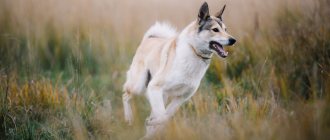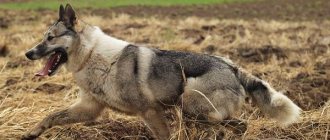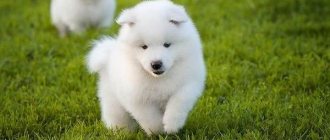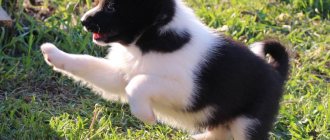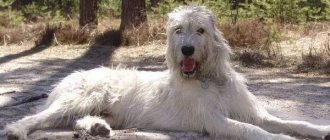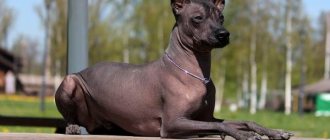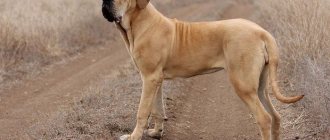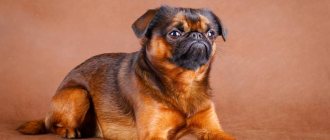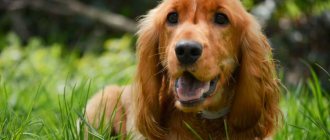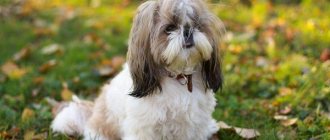The friendly West Siberian Laika is a very proud and independent dog. However, she gives her affection only to members of the family in which she lives. Among its fellow dogs, the Laika will try to take a leading position. She only obeys her owner. She is a real specialist in catching wild boars, large predators, moose and fur-bearing animals. Another purpose of the husky is riding. Now it is very often used in the Urals and Siberia.
The friendly West Siberian Laika is a very proud and independent dog.
Breeding history
Dogs of this breed were bred almost through natural selection, when only the strongest individuals could survive. Taiga hunters, who were a kind of breeders, initially set out to create dogs that would benefit humans. “Benefit” meant help in hunting. Thus, five varieties of huskies were bred:
- Samoyed;
- Karelian-Finnish;
- Russian-European;
- East Siberian;
- West Siberian Laika.
The breed was bred for hunting, and its character and physical characteristics only confirm this purpose.
In the 20s of the last century, the USSR began planned breeding of Siberian huskies and bringing the breed to a single standard. At that time, about 10 varieties were identified, which received the names of the nationalities that bred them (Karelian, Ostyak, Zyryan, Khanty, Mansi and others).
Advertising:
Breed standard
The West Siberian Laika, according to the current standard today, is of medium height, strong, and balanced in structure. When assessing, what will be important is not the exact weight and height data, but the correct proportions of the animal’s body.
West Siberian Laika - soft gold hunter
- Height 58–65 centimeters for males, 52–60 for females.
- Wedge-shaped head. Somewhat elongated, not too wide. The forehead is almost straight, with a pronounced bend at the junction of the muzzle. The bridge of the nose is straight. Well defined occiput and crown. The muzzle is not narrow, but not wide either. Has a slight expansion in the area where the fangs are located. Cheekbones and cheeks are lifted. The eye sockets are practically not expressed (the color with the so-called “eyebrows” creates the opposite sensation). The lips are well adjacent to the muzzle, pigmentation along the lower line.
- The nose is pigmented. Wide and agile.
- The teeth are completely complete. The bite is correct. The fangs are quite large.
- The eyes are almond-shaped, somewhat slanted. The iris is colored brown; according to the standard, darker colors are preferable. The eyelids are completely pigmented.
- The ears are shaped like pointed triangles of regular shape. Constantly raised and mobile.
- The body is rectangular, elongated. The square body format does not correspond to the standard. Strong back. For bitches, a straight back line is acceptable. The withers are pronounced. The neck is not too long, curved, oval. The raised croup flows smoothly into the hips. The chest is muscular and moderately wide. The transition from the groin line to the sternum is not sharp.
- The limbs are powerful, smooth, tightly assembled. The joints are pronounced. The height of the forelimbs is approximately half the height of the animal. The angles of the paw joints are harmonious.
- The tail is in the shape of a ring or sickle (this shape is acceptable only if the tip is thrown over the back).
The hair on the body is hard and very thick.
Dogs have a furry undercoat that provides protection from strong winds and moisture. The fur on the body is hard and very thick. On the muzzle, as well as on the front of the paws, the coat is softer and thinner. The side lines of the head, the back of the paws and the neck have combing.
The standard allows several color options:
- gray (“wolf”);
- brown (red);
- white with a brown or black nose.
It should be noted that since the breed was bred from several types of huskies, individuals within the breed may differ from each other. The appearance of each animal will be more consistent with the type from which its ancestors were.
The West Siberian Laika, according to the current standard today, is of medium height
Standard Features
Distinctive external features of the West Siberian Laika are average height, strong constitution and muscles .
Based on the standard, these animals usually have a height of no more than 50-80 cm. The characteristic shape of the head is triangular with equal hips. They traditionally have a wide skull and a long muzzle. This image is complemented by almond-shaped or oval brown eyes. The ears are usually triangular in shape and erect.
The chest has developed muscles, the stomach is tucked. The legs are quite powerful, the tail is crescent-shaped.
When you first meet the West Siberian Laika, you will be struck by its short fur. The undercoat has a thick layer; in the neck area it is very dense and forms a collar. In accordance with the standard, it is customary to distinguish several types of husky colors:
Sometimes there are black and white animals, but such animals are not very popular.
Character
Despite some external resemblance to a wolf, this is a quite friendly individual. The West Siberian Laika has a very well developed pack sense. Most of the time she stays close to her owners and has a hard time withstanding loneliness. Gets along well with children, especially small ones. Makes an ideal companion and an excellent hunting partner.
Many say that the West Siberian Laika has a stern disposition, inherited from its wolf ancestors. Be that as it may, they are balanced and will never show unfriendliness if they are treated well. But the character of the East Siberian Laika is a little different - they can be impatient with strangers on their territory, although they still treat children with the same reverence. Such animals, like no one else, are suitable for protecting the house and site.
Basic moments
- Karelian-Finnish huskies were bred as universal hunters, equally adept at handling both squirrels and roe deer.
- The excess of cunning and independence among representatives of this breed somewhat hinders them in their studies. Sometimes an animal can be stubborn and pretend, so you will have to look for a special approach to these red-haired rogues.
- Like most hunting dogs, Karelian-Finnish huskies are very energetic animals that require regular physical exercise, so you will have to walk your pet a lot and thoroughly.
- The average “Karelo-Finn” quickly settles into the family, but can conflict with other representatives of the dog tribe if he sees them as rivals. The desire to lead and dominate - nothing can be done.
- The Karelian-Finnish husky is a noisy dog, loving to raise its voice even on the most insignificant occasion, so before you get a tiny red lump, ask yourself: are you ready to live in the company of such a talkative pet.
- Fearlessness and courage are the main hunting characteristics of Karelian-Finnish huskies. At the same time, they are quite prudent and do not attack too large animals.
- One of the most significant advantages of the breed is the compactness of its representatives, in comparison with other huskies. Such dogs do not require much space and are easy to transport, which is important for owners who regularly go hunting with their pets.
- Among lovers of the Karelian-Finnish Laika breed, they are simply called Karelians.
Nicknames for the West Siberian Laika
Many believe that in addition to breed and upbringing, the animal’s disposition can be influenced by its nickname and even the zodiac sign under which the puppy was born. And according to the theory of Boris Khigir, nicknames carry encrypted information about the character of their bearers. You don't have to believe this, but you have to admit that choosing a name for your pet is an important task. We have collected some nicknames that are suitable:
- Alda;
- Ararat;
- Aima;
- Brixie;
- Brawler;
- Vita;
- Winter;
- Vaygach;
- Vesta;
- Storm;
- Hertha;
- Jedi;
- Smoke;
Many people believe that in addition to breed and upbringing, an animal’s character can be influenced by its nickname.
- Darius;
- Euphrates;
- Zarina;
- Zenith;
- Jacquard;
- Indigo;
- Eton;
- Spark;
- Carat;
- Bark;
- Laura;
- Peaceful;
- Alarm;
- Nobel;
- Khazar;
- Chara;
- Chester;
- Rolex;
- Prima;
Despite some external resemblance to a wolf, this is a quite friendly individual
- Shirley;
- Erika;
- Yucca;
- Jasper.
Of course, these are not all the nicknames that may be suitable for West Siberian Laikas. You can name your dog completely differently, the main thing is that the name suits him and is pleasant to the ear.
Caring for the West Siberian Laika
Despite the fact that the standard size is indicated as medium, the dog will look impressive in an apartment. The experience of many owners shows that keeping an animal of this size in the city is quite possible, provided that it is walked at least twice a day and receives exercise in addition to this. If you cannot provide this or there is no suburban area near your home for proper walking, it is recommended to choose a different breed.
All Siberian huskies are quite easy to care for:
- To maintain a neat appearance, comb your dog's coat with a comb once every couple of weeks, paying attention to the undercoat. During shedding, you need to spend a sufficient amount of time brushing. If the undercoat is not shed in time, you will get a “greenhouse effect” - ideal conditions for the breeding of bacteria, which will lead to skin diseases of the pet;
- bathe 2 or 3 times a year. Individuals wearing undercoat should not be bathed without special need. It's practically waterproof, so you have to work hard to get it wet or rinse off the shampoo well. After bathing, make sure the coat is completely dry. Use a hair dryer if necessary.
Proper nutrition is very important for the normal growth and development of Siberian huskies. If you prefer natural food for feeding your pet, make sure that he receives all the necessary vitamins and microelements in addition. It is especially important to give vitamin supplements in the spring and autumn.
Contents in the apartment
Knowing the character, behavior, and even more so the characteristics of this breed, we can say with confidence that a husky in an apartment will feel bored and constrained. These dogs love to see space and freedom, lead an active lifestyle, and feel like they are among wild nature. A closed space inside the city will not give this dog the opportunity to express itself.
The solution may be long walks (preferably with a leash) in the fresh air, in places that resemble the dog’s natural habitat. It is recommended to walk the animal for at least 2-3 hours several times a week.
It is worth thinking about various light loads during this process, letting your pet run and bark. In the apartment you need to clearly define a place for the pet. From a hygiene point of view, this breed requires frequent brushing, otherwise loved ones who cannot tolerate the presence of fur indoors may suffer. In this case, you need to wet clean the house more often.
Training
The main task in training dogs of this breed is to teach them unquestioning obedience. Lessons start at an early age. First, puppies are taught basic commands and only from 10 months they begin special hunting commands. Although the experience of many hunters has shown that training can begin earlier. From this period, training should take place at specialized sites that recreate the conditions that will be encountered during the hunt. At this time, puppies are accustomed to the sounds of gunshots, headlights and other moments that should not distract or frighten the dog.
Choosing a place and utensils for feeding
In order for a puppy to be raised correctly, the place and dishes from which the baby eats are of no small importance. It is recommended to do everything to ensure that the pet feels comfortable and safe when eating.
It is not advisable to feed the puppy together with other animals. To avoid contamination of the place where your pet eats, you can cover the floor with a special rug.
The bowl size should not be too large because huskies do not eat much at a time. To maintain correct posture, the bowl is placed on a stand, which increases as the puppy grows.
To maintain correct posture, the bowl is placed on a stand, which increases as the puppy grows.
How to choose a puppy?
If you want to get an animal and decide that huskies are right for you, make your choice responsibly. Depending on the purpose of the establishment, East Siberian Laika puppies can be purchased in different places. For example, if you need a hunting companion, it is advisable to contact hunters. They will advise you, as one of their own, on the animal that is best suited for this purpose.
First, puppies are taught basic commands and only from 10 months they begin special hunting commands.
If your goal is breeding or you are looking for a companion or guard, we recommend visiting a nursery, where you can usually examine several West Siberian Laikas and choose the one you like best.
When choosing a West Siberian husky, you should not focus on such an indicator as the price of the puppy. The fact is that in this case, animals without an impeccable pedigree, but with good hunting qualities, can cost many times more.
Application
The purpose of this breed was originally hunting. She is a specialist in catching large predators, fur-bearing animals, wild boars, and moose.
Another, but secondary, purpose of the West Siberian Laika is riding. They still walk beautifully in harnesses in Siberia and the Urals.
Now this is not just a good hunter, like, for example, the Russian greyhound, but also a human companion.
Little bear cubs - West Siberian husky puppies
Health
All Laika puppies should receive basic vaccinations up to date. Only after this can they contact other dogs or cats and generally go out into the “outside world”. But don’t forget about helminthiasis, which your pet can pick up on walks. Therefore, take preventive measures against worms on time. Also, while walking, there is a risk of contracting lichen from contact with infected animals. After each time your pet goes outside, be sure to thoroughly check it for tick bites.
With proper nutrition and care, the pet feels good and pleases its owners with its activity. In order not to miss changes in your pet's health, conduct daily examinations, during which you need to check:
All Laika puppies must receive up-to-date basic vaccinations.
- visible mucous membranes;
- nose;
- oral cavity, teeth;
- ears.
This breed is not characterized by hereditary diseases. In general, Siberian huskies get sick quite rarely. Regeneration after serious injuries is quite fast, while representatives of other breeds can even die from such damage. Basically, all the injuries received by the Siberian husky occur in fights with predators during hunting, but it recovers from them quite quickly. Thanks to the metabolism inherited from wolves, such a dog is quickly able to regain strength. After a grueling hunt, a few minutes are enough to recover - just feed your dog well.
Regeneration after serious injuries is quite fast
